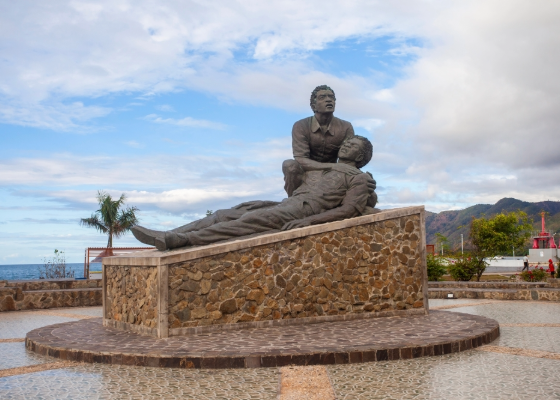Timor Leste: Remembering the past to secure the future
As Timor-Leste strengthens its statehood by becoming a full member of ASEAN, it should not forget the cost of its independence struggle, writes Ivo Mateus Goncalves. For both Timor-Leste and Indonesia remembering their shared history is critical to building a regional order grounded in justice and mutual respect.
18 November 2025

Timor-Leste’s accession to the Association of Southeast Asian Nations (ASEAN) represents a significant milestone in the consolidation of its statehood. Yet, this achievement should be accompanied by a conscious reflection on the nation’s violent origins, which underscore the inherent fragility of both domestic stability and regional peace.
In joining ASEAN, Timor-Leste contributes not only a functioning democratic system but also a unique historical experience shaped by the perils of armed conflict and political upheaval. These attributes position the country as a valuable interlocutor in discussions on peacebuilding and conflict prevention within the region.
A reminder of the enduring relevance of these lessons came with the commemoration on November 12 of the 1991 Santa Cruz massacre—an event that remains emblematic of the profound sacrifices underpinning Timor-Leste’s struggle for sovereignty.
Now, more than three decades later, how is this seminal event remembered by a nation that has since gained its independence, and what lessons does it offer?
Massacre that moved the world
The Santa Cruz Massacre was not the first atrocity committed during Indonesia’s occupation, which began in 1975. But it was the most visible. Unlike earlier incidents—such as the 1983 Kraras Massacre or the 1980s Ainaro killings—that went largely undocumented, this massacre was filmed by journalists such as Max Stahl, whose footage was smuggled out and broadcast globally. The images of young Timorese being gunned down in broad daylight exposed the brutality of the occupation and intensified international pressure on Jakarta.
This moment marked a turning point. It transformed a forgotten conflict into a global cause. The massacre became a rallying cry for human rights advocates, solidarity movements, and international diplomats who would later support the 1999 UN-sponsored referendum that led to Timor ’s independence. It arguably provided the pretext for the award of the Nobel Peace Prize to Jose Ramos Horta and Bishop Carlos Belo.
The massacre also revealed the courage of Timorese youth. Many of those killed were students, some still in their teens. They marched not with weapons, but with banners, flags, and flowers. Their peaceful defiance in the face of overwhelming military force became a symbol of the broader resistance movement—one rooted in dignity, sacrifice, and the unyielding demand for self-determination.
For many Timorese, Santa Cruz is not merely a cemetery—it is a sacred site of resistance. The victims are remembered as martyrs who gave their lives for the dream of a free Timor-Leste. Annual commemorations in Timor-Leste and abroad and pilgrimages to the site serve as acts of remembrance and reaffirmation of national identity.
Yet, as the years pass, the challenge of preserving this memory grows. A new generation has come of age in an independent Timor-Leste, with no direct experience of the occupation. For them, the massacre is history—taught in schools, commemorated in ceremonies, but increasingly distant. The risk is not only that the memory fades, but that its meaning becomes diluted or depoliticised.
Generational distance and diverging memories
One of the most striking challenges in preserving the memory of Santa Cruz is the generational gap. A large segment of Timor-Leste’s youth today has no lived experience of the Indonesian occupation or its historical antecedents. For them, the massacre is a chapter in textbooks, a date on the calendar, and a story told by elders—rather than a visceral memory of fear, resistance, and loss. This distance inevitably transforms a deeply political and moral event into a symbolic ritual, detached from its original urgency.
This phenomenon is not unique to Timor-Leste. It has its parallel within Indonesia, where the same generation has no recollection of Suharto’s authoritarian rule or the invasion of Timor-Leste, allowing the leader who ordered the invasion of Timor Leste to be last week named a “national hero”. For many young Indonesians, the occupation is a footnote in national history, overshadowed by narratives of economic growth and democratic transition.
The implications of this dual amnesia are profound. In Timor-Leste, it challenges efforts to sustain a national identity rooted in sacrifice and resistance. In Indonesia, it raises questions about accountability, historical responsibility, and the ethics of reconciliation. Without deliberate strategies to bridge these gaps—through education, cultural production, and dialogue—the memory of memory of the occupation is eclipsed and its formative effects on nationhood go unrecognised.
Justice still out of reach
Despite global outrage, justice for the many crimes perpetrated between 1975 and 1999, including Santa Cruz, remains elusive. Indonesia has never prosecuted those responsible, and international efforts to hold perpetrators accountable have largely stalled. The Commission for Reception, Truth and Reconciliation in Timor Leste (CAVR) documented numerous cases in detail, but its recommendations remain only partially implemented.
The lack of accountability continues to haunt survivors and families. Many live with trauma, unanswered questions, and a sense of abandonment by both national and international institutions.
Moreover, the political relationship between Timor-Leste and Indonesia has evolved. In the interest of reconciliation and regional diplomacy, successive Timorese governments have prioritised bilateral cooperation over legal redress. While this approach has yielded benefits in trade, security, and ASEAN integration, it has also left many victims feeling that their suffering has been sidelined.
A legacy that endures
Keeping alive the memory of all the events of 1975 and the subsequent occupation is not merely an act of honouring the past—it is a safeguard for the future. Historical amnesia can breed complacency, distort national narratives, and open the door to decisions that undermine both internal cohesion and external peace. For Timor-Leste, remembering the violence, the resistance, and the sacrifices of those years is essential to sustaining democratic values and preventing the recurrence of authoritarianism or external aggression. For Indonesia, acknowledging this shared history is equally critical to building a regional order grounded in justice and mutual respect. Memory, therefore, is not just about the past; it is a strategic resource for peace and stability in Southeast Asia.
As Timor-Leste deepens its engagement with ASEAN and the global community, the memory of tragedies such as Santa Cruz reminds the nation—and the world—of the cost of silence and the power of solidarity. They echo and shape the identity, politics, and aspirations of a young nation still healing from its wounds.
Timor-Leste should not dwell in the past—it should honour it, learn from it, and carry it forward.
Ivo Mateus Goncalves is a historian and the 2025–2026 CSEASI Visiting Fellow at the Asian Institute, University of Toronto. His research focuses on memory, resistance, and postcolonial transitions in Southeast Asia.
How can we help? Get in touch to discuss how we can help you engage with Asia
